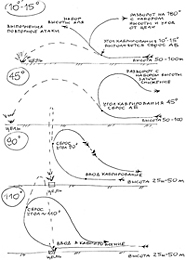
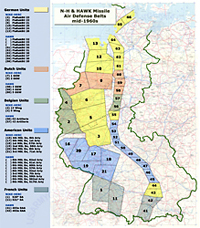 An instruction officer of the Bundeswehr who wanted to remain anonymous, specialized in the Improved Hawk system
commented: ‘Globally, this tactic could have been successful. But at what cost? Today, that kind of operation would be more
difficult as the different air defence sites are well linked together and the range of the Improved Hawk has been much
increased. Much more attackers would be required. But the Warsaw Pact introduced the ARM missiles, which were later improved
themselves to counter the evolution of the Hawk system. A big flaw of the Hawk system is still the small number of targets
[only one at a time] that
can be treated by one illuminator radar. The LASHE-Mode (Low Altitude Simultaneous Hawk Engagement) was introduced with the
PiP 3 (Product Improvement Plan 3), which permitted to deal with such saturation attacks (1).
I am most surprised by the attack on three sites only. A Hawk batallion was composed of a headquarters [BOC] and four batteries.’
An instruction officer of the Bundeswehr who wanted to remain anonymous, specialized in the Improved Hawk system
commented: ‘Globally, this tactic could have been successful. But at what cost? Today, that kind of operation would be more
difficult as the different air defence sites are well linked together and the range of the Improved Hawk has been much
increased. Much more attackers would be required. But the Warsaw Pact introduced the ARM missiles, which were later improved
themselves to counter the evolution of the Hawk system. A big flaw of the Hawk system is still the small number of targets
[only one at a time] that
can be treated by one illuminator radar. The LASHE-Mode (Low Altitude Simultaneous Hawk Engagement) was introduced with the
PiP 3 (Product Improvement Plan 3), which permitted to deal with such saturation attacks (1).
I am most surprised by the attack on three sites only. A Hawk batallion was composed of a headquarters [BOC] and four batteries.’
Western observers, beside the observation of the infrastructure of the Soviet airfields, were particularly interested in the
tactics related to the delivery of nuclear bombs.
The LABS (Low Altitude Bombing System or toss bombing) bombing technique was considered as the preferred means to drop a
nuclear bomb. That was the case during the 1960s for the Su-7 and the MiG-21.
During a LABS delivery, the pilot pulled on the stick to climb vertically. The bomb was released during the climb while the pilot
continued to pull until flying inverted reversing its course at the same time. Once released, the bomb continued on its impetus
forwards and upwards for a while before falling finally to the ground.
Although the path of the bomb was predictable, this method was not so accurate but that was obviously not an issue for a nuclear
attack.
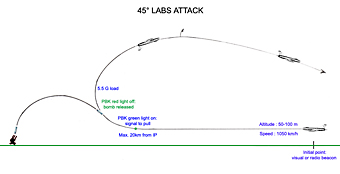 The technical aspects of the LABS bombing technique are not widely known. As an example, we will discuss of the
procedures used by the Su-7 fighter-bomber wings.
The information has been collected during the early 1970s from Warsaw Pact defectors from Czechoslovakia and USSR
(E. Lvoich of the 497.IBAP - see > Special weapons). The LABS procedure was
safer for the pilot approaching its target as in some cases, he could release the bomb well before reaching the target area
and as the bomb did not fall to the ground immediately, it left some time to the pilot to escape in a reverse direction.
It is not known if parachute retarded nuclear bombs would have been used in those circumstances. In order to fulfil that type
of mission, a Su-7 had to be equipped with a dedicated weapon pylon (BD3-56FN under the fuselage on the left side) and a
special bombsight. The latter was known as the PBK (Pritsel dliya Bombometaniya s Kabrirovaniya or bombsight with
pitching). The electronics for the PBK computer were located in the nose behind the SRD-5 range finder,
whereas the control and indicator box of the system was fixed on the top of the cockpit dashboard, to the left of the ASP-5
head-up display.
In order to attack a precise target, the navigation to the target area, the flight altitude and the final approach to the
target had to be calculated with precision. The attack had therefore to be done from predetermined direction and speed.
When the aircraft was flying within the
parameters indicated by the bombing system, the bomb was released automatically during the vertical climb. It was possible
to release the bomb at an angle of 45, 90 or 110 degrees; 45° seemed to be the preferred angle, as on average, the distance
between the release point and the target was around 7 kilometres.
The technical aspects of the LABS bombing technique are not widely known. As an example, we will discuss of the
procedures used by the Su-7 fighter-bomber wings.
The information has been collected during the early 1970s from Warsaw Pact defectors from Czechoslovakia and USSR
(E. Lvoich of the 497.IBAP - see > Special weapons). The LABS procedure was
safer for the pilot approaching its target as in some cases, he could release the bomb well before reaching the target area
and as the bomb did not fall to the ground immediately, it left some time to the pilot to escape in a reverse direction.
It is not known if parachute retarded nuclear bombs would have been used in those circumstances. In order to fulfil that type
of mission, a Su-7 had to be equipped with a dedicated weapon pylon (BD3-56FN under the fuselage on the left side) and a
special bombsight. The latter was known as the PBK (Pritsel dliya Bombometaniya s Kabrirovaniya or bombsight with
pitching). The electronics for the PBK computer were located in the nose behind the SRD-5 range finder,
whereas the control and indicator box of the system was fixed on the top of the cockpit dashboard, to the left of the ASP-5
head-up display.
In order to attack a precise target, the navigation to the target area, the flight altitude and the final approach to the
target had to be calculated with precision. The attack had therefore to be done from predetermined direction and speed.
When the aircraft was flying within the
parameters indicated by the bombing system, the bomb was released automatically during the vertical climb. It was possible
to release the bomb at an angle of 45, 90 or 110 degrees; 45° seemed to be the preferred angle, as on average, the distance
between the release point and the target was around 7 kilometres.
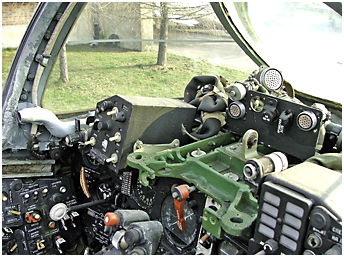
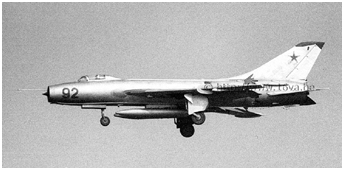 When possible, a radio beacon could be dropped by an
helicopter in the target vicinity. This radio beacon was the initial point from which the final bombing run could start.
A switch on the PBK box allowed a selection between a ‘visual’ (VIZ - visual fix point) or an ‘automatic’ (MARKER – radio
beacon) bombing run. At this point, the speed had to be around 1050 km/h, the altitude situated between 30 and 100 meters
and the flying course right on track. These parameters were valid for all Su-7 and next-generation Su-17 versions. The
altitude was checked with the altimeter, whereas the flight course was corrected with the help of the left and right red
arrows situated on the bottom of the PBK box. The distance flown after the initial point could not exceed 20 km.
In automatic attack condition, a green light lit on the PBK box
after a precisely calculated time, signalling to the pilot that he had to push the throttle to 100% and to pull the stick to
start the vertical climb with a 3.5 to 5.5 G load. That time had to be determined - according to the selected flight parameters
- and introduced into the PBK computer on the ground, before the flight. The bomb was then automatically released at the
predetermined angle. If a manual bomb release was considered necessary, the initial point could not be missed. The artificial horizon
and the accelerometer had to be monitored constantly. A usual attack was flown with the wings level or with a slight bank angle
between 5 and 30°. The bomb was manually released according to the information provided by the HUD.
When possible, a radio beacon could be dropped by an
helicopter in the target vicinity. This radio beacon was the initial point from which the final bombing run could start.
A switch on the PBK box allowed a selection between a ‘visual’ (VIZ - visual fix point) or an ‘automatic’ (MARKER – radio
beacon) bombing run. At this point, the speed had to be around 1050 km/h, the altitude situated between 30 and 100 meters
and the flying course right on track. These parameters were valid for all Su-7 and next-generation Su-17 versions. The
altitude was checked with the altimeter, whereas the flight course was corrected with the help of the left and right red
arrows situated on the bottom of the PBK box. The distance flown after the initial point could not exceed 20 km.
In automatic attack condition, a green light lit on the PBK box
after a precisely calculated time, signalling to the pilot that he had to push the throttle to 100% and to pull the stick to
start the vertical climb with a 3.5 to 5.5 G load. That time had to be determined - according to the selected flight parameters
- and introduced into the PBK computer on the ground, before the flight. The bomb was then automatically released at the
predetermined angle. If a manual bomb release was considered necessary, the initial point could not be missed. The artificial horizon
and the accelerometer had to be monitored constantly. A usual attack was flown with the wings level or with a slight bank angle
between 5 and 30°. The bomb was manually released according to the information provided by the HUD.
There is no sufficient information available to draw conclusions about the tactics that could have been used during the
eighties with different aircraft types (MiG-23, MiG-27, Su-24, MiG-29) against a more lethal Hawk missile system (PiP 3).
One can however stress that new ARM missiles were available as well as specialized ECM helicopters
(Mi-8SMV) although the Hawk missile system seemed well protected against electronic counter-measures (2).
Also, it is not known if the fighter and fighter-bombers currently in service with the Russian VVS have kept a nuclear capability.
- Short video showing a Su-7 armed with a IAB-500 bomb to download >Here
notes
(1)
In LASHE mode, the illuminator radar could have treated 6 targets at the same time - that is 12 per battery. Missiles would have been fired in
salvos.
(2)
Here is a theoretical scenario in case of a modernized Hawk battalion (three active sites) attack during the eighties.
1. Two targets per minute could be treated on average by one fire section, i.e. 4 per battery. Consequently, three batteries
could destroy at least
12 aircraft per minute. An attacking aircraft flew typically 20 kilometres per minute and could be engaged at a distance of 80 km. In an ideal
situation, a Hawk unit could engage 4 x 12 = 48 targets before being saturated.
2. Three launchers for each section held each three missiles = 18 for each battery and 54 for a Hawk battalion. As the effectiveness of a Hawk
missile was estimated at 90%, 48 of the 54 missiles were supposed to reach their target. After that, if more aggressors were coming, you could
just sit and watch them flying overhead as it took 10 minutes to reload the launchers…
This theoretical scenario does not take into account possible electronic countermeasures and the use of ARM missiles. If the latter had been
shot, Hawk missiles would have been launched against them.
This chapter is an expanded adaptation of a text included in the article entitled 'Sowjetische Atombomben
in Europa - Ein Kapitel aus dem Kalten Krieg' by Stefan Büttner, published in the September 2008 issue of Fliegerrevue
Extra 22 (See Multimedia section).
 |
Hawk strike < Part 1 |
 |
Plan du site - Sitemap |  |
